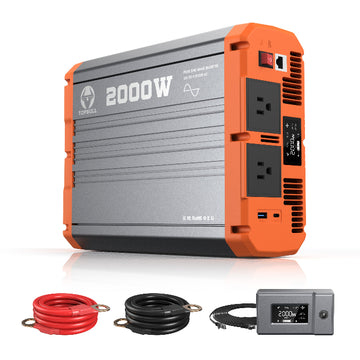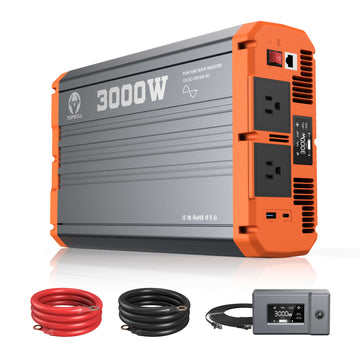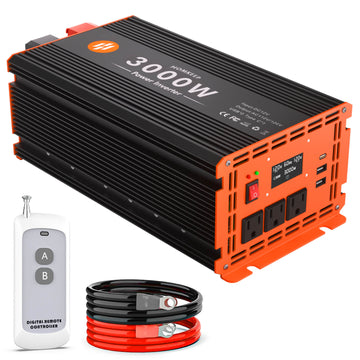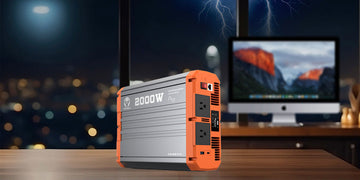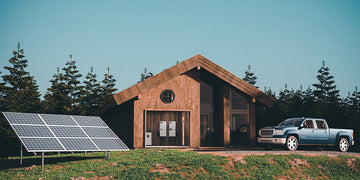When you're choosing an inverter for home backup power, RV power, or an off-grid solar system, the choice between 48V and 12V can be confusing. The voltage difference may seem small, but it has a direct impact on system efficiency, safety, and long-term costs. In this article, we'll take a closer look at the differences and recommend an inverter solution you can trust.
Main differences between 48V and 12V inverters

Efficiency and energy loss
Part of the energy lost in a system is in the form of heat generated as current flows through wires. The higher the current, the higher the losses. A 48V system requires less current for the same power load, which reduces losses and improves overall efficiency.
For example, for a 3000W load, a 48V system requires only 62.5A of current. This means you can use smaller diameter (#6 AWG), longer cables. Particularly suitable for scenarios where the solar panels are far from the inverter, the line loss can be as low as 3%-5%, improving the safety of the system.
For 12V inverters, the current is as high as 166A when the power exceeds 2000W. More energy is lost when power is transmitted over long distances. There is also the risk of overheating, which requires additional fusing.
Cost
Users are very concerned about price when choosing an inverter, and cost is often the key factor. 12V inverters are initially cheaper, but the gap is slowly closing in terms of long-term investment.
Power loss costs (based on 10 kWh per day):
| System Type | 12V | 48V |
| Line Loss Rate | 12% | 4% |
| Annual Loss Consumption | 438 kWh | 146 kWh |
| Electricity Loss ($0.15/kWh) | $65.7 | $21.9 |
Over a 10-year period, a 48V system can reduce electricity costs by $438. A 12V system has a low initial cost and is compatible with standard car batteries; a 48V system requires a special battery pack, but saves on wiring and equipment costs in the long run, making it suitable for large-scale solar energy storage.
Installation complexity
The 12V system is relatively simple, usually the user can DIY to complete. For the car inverter can also be plug and play. The installation of 48V inverters requires complex technical requirements and a number of specialized technologies.
Pros and cons of 48V inverter
Pros:
- Higher efficiency: The biggest benefit of a 48V system is the significant reduction in power dissipation. This means less wasted power, longer battery life, and lower operating costs.
- Better thermal management: With lower power requirements, 48V inverters generate less heat during operation, simplifying thermal management and reducing the risk of performance degradation or equipment damage due to overheating.
- Expansion flexibility: Easier to expand without major upgrades as energy needs continue to grow.
cons:
- Higher cost: 48V inverters must use high-voltage lithium battery packs and require specialized installation. 48V systems typically cost 3-4 times as much to start up as 12V.
- Requires retrofitting: The installation procedure for 48V inverters is more complex. In addition to this, some systems originally designed for 12V require additional modifications or modifications to utilize a 48V inverter.
Pros and cons of 12V inverter
Pros:
- Low energy cost: 12V inverter is especially suitable for users with limited budget. 12V system battery options are flexible, compatible with used car batteries, AGM deep-cycle batteries, and even DIY lead-acid battery packs.
- Wide range of applications: 12V battery inverters are widely used in a variety of small devices and systems, such as automobiles, camping equipment, small solar systems, etc. Their stability and reliability have been widely proven.
- Lightweight and portable design: 12V inverter has more size advantage. topbull 2000W pure sine wave inverter weighs only 6 pounds and can be carried by one hand.
Cons:
- Efficiency Limitations: 12V inverters have difficulty handling high power demands. The efficiency of the system will be unstable when handling high power loads.
- Scalability Limitations: 12V systems may require larger changes to accommodate increasing power demands, requiring the replacement of all batteries and cables. However, when more than four lead-acid batteries are connected in parallel, uneven charging and discharging may result in shorter life.
How to choose? List of key questions
What is your power requirement?
When power requirements are concentrated in the 1500W-4000W range, such as RVs, campers and small solar systems, a 12V inverter is the more economical choice.
Once power exceeds 4000W, the efficiency benefits of a 48V system are magnified exponentially. If you need to power high power systems, such as large solar systems, industrial equipment, etc., a 48V inverter may be a better choice.
Is scalability needed?
When it comes to cost, scalability is the key to long term costs. Modern 48V inverters have better scalability and can be easily expanded from 5kW to 15kW.
But even with high-end lithium battery packs, there are still hard limits to the scalability of a 12V system. Replacing the battery pack and cables with larger ones is not only expensive, but also less efficient!
Environmental requirements for use?
High temperatures and long distance scenarios are both areas where 48V inverters absolutely rule. Due to the low power requirements, 48V inverters generate less heat during operation, allowing for better thermal management. For longer cable requirements, 48V systems are also completely stress-free without the worry of voltage drops.
If your mounting space is particularly tight, a 12V inverter offers the added benefit of being mobile.
Cost-effective 12-inverter solution
If you need high power output and are on a budget, the Topbull 12V 3000W Pure Sine Wave Inverter is the highest overall rated solution available. This model breaks new ground with 3000W of continuous output power in a 12V system.

If you need high power output and are on a budget, the Topbull 12V 3000W Pure Sine Wave Inverter is the highest overall rated solution available. This model breaks new ground with 3000W of continuous output power in a 12V system.
Core advantages
1. Instantaneous overload capability:
- Support 6000W peak power (for 5 seconds), can start 1.5HP water pump or high power power power tools
- Exclusive intelligent frequency reduction technology, overloaded by 30% but still safe operation for 15 minutes
2. Compact thermal design:
- Dual intelligent temperature control fans, effectively reduce the inverter temperature
- Measured 45 ℃ environment continuous operation for 4 hours, the core temperature stabilized at 71 ℃ (industry average 81 ℃)
3. Full Scenario Compatibility:
- 2 U.S. standard AC outlets, USB and Type-C fast charging ports
- Equipped with remote control switch (with display)
- UL458 marine safety certified and waterproof to IP55
Parameter comparison
| parameters | Industry 3000W model average | Topbull 3000W |
| No-load power consumption | 25W | 18W (energy-saving mode) |
| Waveform Distortion Rate | ≤5% | ≤3% |
Applicable Scenarios
- Emergency power supply for RV: run 2 air conditioners at the same time (need to match 200Ah lithium battery pack)
- Mobile workshop: driving angle grinder (2000W) + inflatable pump (800W)
- Temporary activity power supply: concert sound system + lighting combination
FAQ
Q: Is a 48V inverter better than a 12V?
A: 12V and 24V inverters have their own advantages, which one is better depends on your needs. 48V is more suitable for high power applications with higher efficiency. 12V is suitable for small applications with lower cost and easy installation.
Q: What are the benefits of 48V over 12V?
A: Higher efficiency, less power loss. Scalable and suitable for high power, long distance systems.
Q: Should I get a bigger inverter than I need?
A: Yes, you can choose an inverter that is 20-30% larger than your needs. For example, if your peak load is 2500 watts, choose a 3000 watt inverter. However, avoid oversizing the inverter; inefficient operation of the inverter will result in energy loss.

